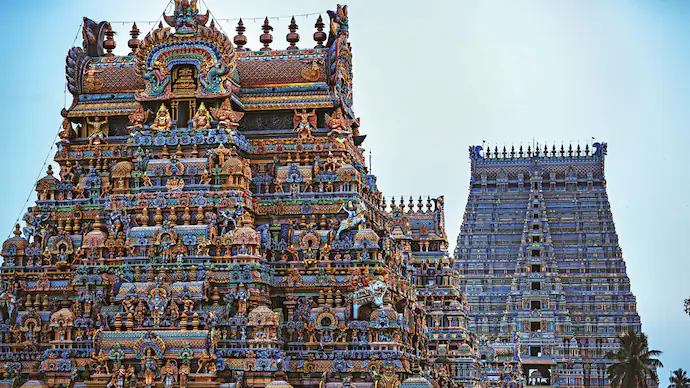The issue of government control over Hindu temples in India has become a focal point for various political and religious organizations, particularly with the recent outcry surrounding the Tirupati laddoo controversy. Groups like the Vishwa Hindu Parishad (VHP) are leading calls to “free” temples from government oversight, framing the debate as a matter of religious freedom and cultural identity. This blog explores the historical roots of temple governance, the evolution of government control, and the contemporary demands for autonomy.
Historical Context: Colonial Roots of Temple Control
The regulation of Hindu temples in India has its origins in the colonial era. The British, seeking to maintain order in a diverse society, implemented laws that allowed them to exert control over religious institutions. One pivotal piece of legislation was the Madras Hindu Religious and Charitable Endowments Act of 1925, which aimed to curb mismanagement and corruption in temple finances by placing them under government oversight.
This act served as a blueprint for various states post-independence, leading to the establishment of state-run boards that manage the administration and finances of major temples. While the intent behind these laws was to ensure accountability, they effectively stripped temples of their traditional autonomy, creating a governance model that many Hindus now see as a vestige of colonial rule.
Post-Independence Dynamics: Retention of Control
Upon gaining independence in 1947, India adopted a secular constitution that emphasized religious freedom. However, many of the laws governing temple management remained intact. The Indian government justified the continued oversight of Hindu temples by arguing that state involvement was necessary to prevent misuse of funds and to ensure that temple resources were used for community welfare.
The result has been a dual system where Hindu temples are often treated as public institutions, while places of worship for other religions, such as mosques and churches, operate largely free from state intervention. This discrepancy has fueled resentment among Hindu communities who feel their religious rights are being compromised.
The Call to ‘Free’ Hindu Temples: Hindutva Organizations Take a Stand
The recent Tirupati laddoo controversy, which involved allegations of government interference in temple rituals and distribution practices, has reignited discussions about the autonomy of Hindu temples. Following this incident, the VHP and other Hindutva organizations have intensified their campaigns, calling for a complete withdrawal of government control over Hindu temples.
The VHP has framed this demand as a restoration of Hindu pride, arguing that continued government oversight is reminiscent of the colonial mindset that historically marginalized Hindus. The organization emphasizes that Hindus should be allowed to manage their places of worship as other religious communities do. They argue that the essence of Hinduism is deeply tied to its rituals, traditions, and management practices, which should not be subject to bureaucratic control.
Political Support for Temple Autonomy
In this evolving discourse, political leaders like Pawan Kalyan, the Deputy Chief Minister of Andhra Pradesh, have publicly supported the movement to free temples. Kalyan has suggested the establishment of a Sanatana Dharma Rakshana Board to address issues affecting temples, such as land disputes and ritualistic practices. His statements have resonated with many who feel that government intervention undermines the sanctity of Hindu practices.
Moreover, the support from political figures lends credibility to the demands of Hindutva organizations, potentially transforming a grassroots movement into a significant political issue. The ongoing discussions highlight a broader struggle for recognition and respect for Hindu traditions within the framework of a secular state.
Comparative Governance: Hindu Temples vs. Other Religious Institutions
The disparity in governance between Hindu temples and other religious institutions remains a contentious point. While mosques are managed by Waqf boards and churches by Christian trusts, Hindu temples are still predominantly under state control. Critics argue that this inconsistency violates the principle of equality enshrined in the Indian constitution, as it subjects one religious community to a different set of regulations.
This inequity raises fundamental questions about the nature of secularism in India. Many argue that true secularism should ensure equal treatment for all religions, allowing each community to govern its places of worship according to its traditions and beliefs. The demand to “free” Hindu temples is thus not merely a call for deregulation; it embodies a deeper quest for parity in religious governance.
Navigating the Future of Temple Governance
The debate surrounding government control of Hindu temples is complex, intertwining historical grievances with contemporary demands for autonomy. As organizations like the VHP and leaders like Pawan Kalyan mobilize support for their cause, the question of how temples are governed will likely remain a significant issue in Indian politics.
To navigate the future of temple governance effectively, a balanced approach that respects religious freedoms while ensuring accountability is essential. The resolution of this debate could redefine the relationship between the state and religious institutions in India, potentially setting a precedent for how all faiths are treated in a diverse society.
As discussions continue, the calls for autonomy will likely persist, reflecting a broader movement among Hindus to reclaim their religious identity and autonomy in a country where the complexities of secularism and diversity are continuously evolving.


Leave a Reply